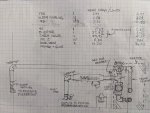- Dec 13, 2020
- 908
- Pool Size
- 19600
- Surface
- Plaster
- Chlorine
- Salt Water Generator
- SWG Type
- Jandy Aquapure 1400
Hi. The pool "professional" who plumbed our SWG put it before the heater. We bought the house this past summer. It took me some months of study here and elsewhere to learn this "a bad thing"... that chlorine from the generator will eat the heater for breakfast. Previous owners said they had replaced it a year before. This was a selling point for the house. Hah. I'd like not to replace it again next year.
When I figured this out, it was almost time to turn off the SWG for the winter anyway. So I switched to pucks in a floater. Need to get this fixed before spring opening. (We're in NC, so are open through the winter, using the spa.)
Anyway I'd like to re-plumb it myself. I'm pretty handy and have done some general plumbing, but never a pool. So I'm asking for thoughts and pitfalls to avoid.
Here is the equipment pad now. It's surrounded by tall hedges with 2-story brick wall at the rear, so getting decent pictures isn't easy:

All the equipment except the jet pump on the right is in my sig block. Note the elegant "rats nest" wiring. Still need to clean that up...
As you can see, there's not a lot of space. Nearly all the pipe is low: below 14 inches from the pad. The lines needing change are against the wall in the back. The only solution I can see is to use more vertical space back there.
Here is a sketch of the proposed new layout from the "front," looking directly at the brick wall.

This is pretty close to scale. The SWG (Jandy Aquapure) has the sensors inside. Note you can see the gas line for the heater is _above_ everything else in the photo. But here it's _below_ the topmost PVC. Overall this plumbing stands about a foot higher than the existing back there.
Hope this is clear enough. Happy to answer questions. If you see anything else egregiously wrong with the existing plumbing, please say that, too.
I really appreciate all the help received here to date. I'm about 4 months into pool ownership, and it feels like drink from a fire hose. Your generosity with expertise is a great gift. Best to all for the holidays...
When I figured this out, it was almost time to turn off the SWG for the winter anyway. So I switched to pucks in a floater. Need to get this fixed before spring opening. (We're in NC, so are open through the winter, using the spa.)
Anyway I'd like to re-plumb it myself. I'm pretty handy and have done some general plumbing, but never a pool. So I'm asking for thoughts and pitfalls to avoid.
Here is the equipment pad now. It's surrounded by tall hedges with 2-story brick wall at the rear, so getting decent pictures isn't easy:

All the equipment except the jet pump on the right is in my sig block. Note the elegant "rats nest" wiring. Still need to clean that up...
As you can see, there's not a lot of space. Nearly all the pipe is low: below 14 inches from the pad. The lines needing change are against the wall in the back. The only solution I can see is to use more vertical space back there.
Here is a sketch of the proposed new layout from the "front," looking directly at the brick wall.

This is pretty close to scale. The SWG (Jandy Aquapure) has the sensors inside. Note you can see the gas line for the heater is _above_ everything else in the photo. But here it's _below_ the topmost PVC. Overall this plumbing stands about a foot higher than the existing back there.
Hope this is clear enough. Happy to answer questions. If you see anything else egregiously wrong with the existing plumbing, please say that, too.
I really appreciate all the help received here to date. I'm about 4 months into pool ownership, and it feels like drink from a fire hose. Your generosity with expertise is a great gift. Best to all for the holidays...
Last edited:

